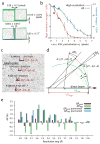Accurate macromolecular structures using minimal measurements from X-ray free-electron lasers
- PMID: 24633409
- PMCID: PMC4008696
- DOI: 10.1038/nmeth.2887
Accurate macromolecular structures using minimal measurements from X-ray free-electron lasers
Erratum in
- Nat Methods. 2015 Jul;12(7):692
Abstract
X-ray free-electron laser (XFEL) sources enable the use of crystallography to solve three-dimensional macromolecular structures under native conditions and without radiation damage. Results to date, however, have been limited by the challenge of deriving accurate Bragg intensities from a heterogeneous population of microcrystals, while at the same time modeling the X-ray spectrum and detector geometry. Here we present a computational approach designed to extract meaningful high-resolution signals from fewer diffraction measurements.
Conflict of interest statement
The authors declare no competing financial interests.
Figures


References
-
- Neutze R, et al. Nature. 2000;406:752–757. - PubMed
Publication types
MeSH terms
Substances
Associated data
- Actions
Grants and funding
LinkOut - more resources
Full Text Sources
Other Literature Sources

